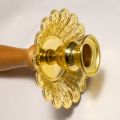This website uses cookies to ensure you get the best experience on our website. Read more
Icon Stands
An analogion, more than a church furniture item
In the Orthodox Church, an analogion is a lectern, a stand on which a gospel, a service book, or an icon is placed at church or in the home. Originally, congregations used just one analogion, but eventually, they came to utilise at least two - one for the Gospel and one for the Epistle. Welcome to our catalogue's analogia section, which has products of various designs and for varied functions, both at church and at home.
It is a rare church these days that does not have an analogion at its centre. The central analogion, which is shaped like a cabinet, is an icon stand richly ornamented with exquisite carvings. This creates a pious and contemplative environment in the church. In the past, its surfaces were painted with coloured designs and even icons, but this is no longer the case. Covering the central analogia with an embroidered cloth is now more prevalent. Another ancient practice was to make analogia out of stone. This custom has long disappeared, so we do not have any stone analogia in store, we are afraid.
The central analogion is also used as a church icon stand for the depictions of the feast or saint commemorated on a particular day. For the most prominent feasts, the Orthodox icons on the stand are decorated with fresh flowers. A candlestand is usually placed next to it to provide illumination and allow the worshippers to contribute candles.
Analogia are no longer immobile. Most parishes now choose lightweight versions that can be quickly moved about as needed. The analogion outside the Royal Doors supports the gospel from which the clergy read during services. It is usually a foldable lectern with a fabric or wooden top. This type of analogion is also found at the altar.
During confessions, wooden, non-foldable analogia with a basic design is used. The priest stands nearby as the penitent venerates the Gospel and Cross before kneeling in front of the analogion to make his confession. Chanters in the kliros use an analogion with two or three sides that rotates to provide easy access to liturgical books. Ancient monasteries on Mount Athos and elsewhere utilise an octagonal shape with a flat, rather than a sloping, top. It is occasionally inlaid with mother of pearl or other semi-precious stones. A tetrapod is a unique type of analogion. It is often placed in the centre of the church, draped, and used to bless icons, crosses, and other sacred objects.
An analogion is a piece of furniture employed in domestic and church prayer. However, it also symbolizes spiritual ascent and advancement. Anything we place on it becomes closer to heaven, and hence superior to others. Some analogia are created in the shape of an open-winged dove, which represents the Holy Spirit's descent. Browse our large selection of analogia created in the studios of Saint Elisabeth Convent. Whichever you select, we hope it will take your church and prayer life to new heights.























